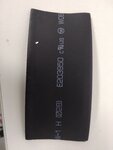anjalina
Newbie
Hello Sir/ Ma'am,
Currently we are using 433.92 MHz RF frequency, with the covering of rubber sleeve(Heat shrinkable) on the transmitter device. For reference please go through below link:
We are expecting our range of 12 to 15 meter between TX and Rx, but we get the range of 6 to 7 m by using current sleeve. So please suggest the best sleeve material to get appropriate range according to our requirements.
Note: The sleeve material should be heat shrinkable with less diameter(about 28 mm) , thickness should be less than 0.5 mm, black colour sleeve without glossy look.
Currently we are using 433.92 MHz RF frequency, with the covering of rubber sleeve(Heat shrinkable) on the transmitter device. For reference please go through below link:
We are expecting our range of 12 to 15 meter between TX and Rx, but we get the range of 6 to 7 m by using current sleeve. So please suggest the best sleeve material to get appropriate range according to our requirements.
Note: The sleeve material should be heat shrinkable with less diameter(about 28 mm) , thickness should be less than 0.5 mm, black colour sleeve without glossy look.
